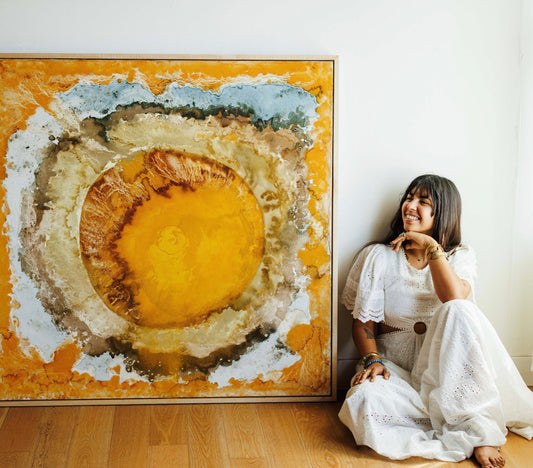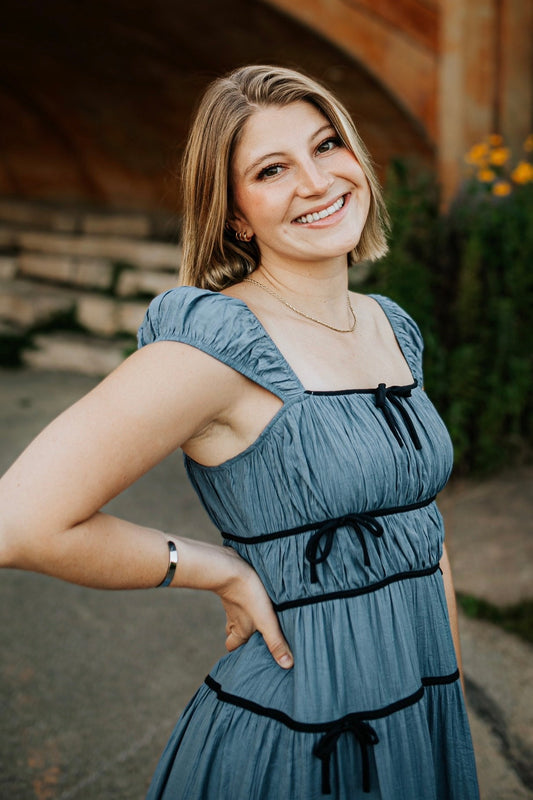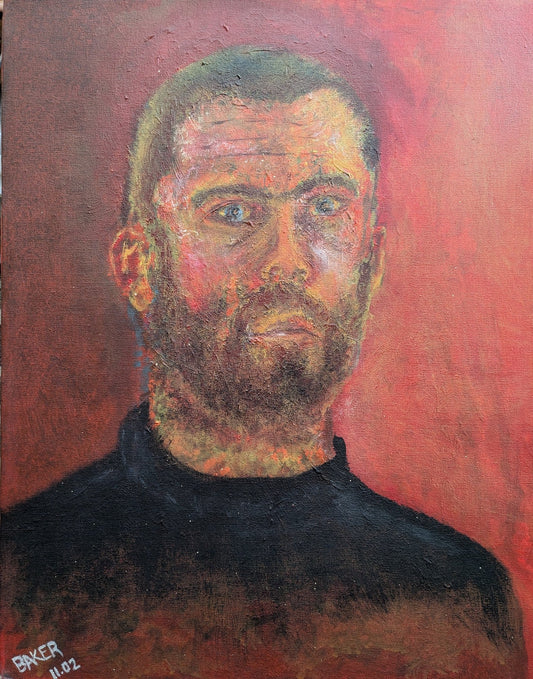The Soul of Portraits
There is something so unpredictable yet predictable about portraits. They’ve been around since the creation of humanity, a way to record history and its people. We’ve seen some of the most famous pieces like Vertumnus (1591), Girl with a Pearl Earring (1665), and Portrait of Madame X (1884)—all famous because of the features portrayed on a canvas. Unique upturned noses, slicing cheekbones, and a mysterious gaze piercing into the souls of viewers. Much like these, Keemo from Grand Rapids, Michigan, takes the common portrait and reinvents it. Through “abstract neo-expressionism mixed with cubism” the mysterious Keemo turns Pablo Picasso on his head to become one of the best portrait painters of his niche. Keemo’s motto is simple: Original Art For Original People.

Original Art 4 Original People
Wanting to separate himself from other artists, in 2007 Keemo created the motto: Original Art For Original People—a way that “celebrated the people who were actually enjoying my [his] art, because they tend to be original kind of people.” Keemo’s platform was created around just this. Keemo is not only a painter, he’s an author, a husband, a critical thinker, and most of all, Keemo is utterly himself. That’s why his art does so well. His work as an artist is to explore the human condition, an experience that is singular to every individual, “our most realistic portraits are abstract.” It’s not what we look like on the outside, it’s our idiosyncrasies, unique only to ourselves and our personalities. Not only does Keemo create one of a kind portraits, he also incorporates words into them. A mixed-media frenzy of what it’s actually like to be original, to be human.
From a 2013 portrait of an unnamed person, Keemo conceptualizes what their inner dialogue may be—an intimate yet subjective portrayal of the universal stream-of-consciousness one experiences:
There is rain. A lot of it. and the sound as it hits the ground reminds me that all things eventually are washed clean and there is thunder. a lot of it. and the sound of it reminds me that all my ideas are temporary and can be realigned in an instant with just the right nudge and there is wind. a lot of it. and it reminds me that all things move in a direction that we have no control over and when this is all over we will all still be here but we will not ever be the same.
It’s original, but relatable, which is how Keemo’s work has found its place in not only the homes, but the hearts of many. His poetry is a way to connect the viewer’s innermost thoughts to their love of art. There is little room for interpretation when reading a flow of consciousness prose, rather than looking at an abstract piece of art with the naked eye.


Commissions
Through his commissions, Keemo is able to take the personalities of his subjects and translate them into what he believes is their true selves. “A lot of times how I think we want to define ourselves is not actually how we are.” That is the exact reason why Keemo always paints portraits; because real people are the one thing that “transforms an abstract, creative idea into something tangible” that many can connect with on a personal level. One thing Keemo always ensures is that before completing any commission, he gets to know his subject better; it’s a requirement. This is to capture what makes each individual unique, so he is able to capture their most personal traits like a snapshot onto a canvas. It’s intentional, much different from pieces he completes with simple rules—absolutely every part of Keemo’s commissions has to be perfect, down to the line. Keemo’s degree in psychology has allowed him to look deeper into people who commission his work. He sees past wedding rings, if you’re a Christian, man, or woman, and sees people for what they really are. Complex beings.


Life in the Abstract
Before becoming a full-time artist, Keemo grew up in Grand Rapids where he always knew he was going to be an artist or do something artistic. It’s almost poetic that the place where he grew up is the place he became successful, even after leaving for some time. When he was fifteen years old, Keemo remembers sitting on his bedroom floor, not thinking about what he was doing and holding oil pastels. Keemo let the art take over him like a trance, and half an hour later, his mind awoke and when he looked down onto his canvas, Keemo thought, “holy cow. I’ve never made anything like this and I felt like something was kind of untapped at that point.” From that point on, Keemo stopped drawing cars and cartoons and opened “a path of exploration” that made him realize that art is something that could “be something more.” Something far bigger than a picture of a car on paper, or a doodle of a cartoon character—art became Keemo’s life, the way he made people’s eyes light up in a portrait, art became his way of reading people.
Keemo’s degree in psychology has given him the ability to have a different outlook on the human condition and himself. This has allowed Keemo to understand his process as not just finishing his pieces to get them done, but to understand the why behind his process in finishing his work. It’s truly masterful, the way Keemo describes his life with an immense understanding of who he is and how to read people. How he is able to relinquish his talents with acrylic paint onto a canvas, capturing people’s souls and putting them on display.


Creative Process and Color Choice
Like many artists, Keemo’s work begins with a muse, an idea, or an inspiration. Much of this stems from wanting to create something for solace, not just for the act of creation itself. Keemo first starts by just getting out of bed and saying to himself, “I’m going to make something today.” But in reality, Keemo doesn’t have any clue what he’s going to create. He only knows that his little studio tucked behind his house is “an open spot to be creative.” When he is in his creative space, Keemo might have “a blank canvas… a piece of wood, or an old paint by numbers.” Keemo just puts it up on an easel and allows himself to “kind of sit with it for a bit and let it start to have kind of this inner conversation with it.” Keemo follows the power of his thoughts and lets it connect with his pieces to form a sort of Nirvana or Arcadia cascading onto a canvas. His creative process is meditative. He finds solace in the idea of creating something new each and every day. Keemo’s process changes so often that there is no rhyme or reason to it—it simply just comes to him.
A large reason for Keemo’s success is that he doesn’t follow the formal rules of art, he makes his own rules. If he cannot think of the right color to use, Keemo will text his daughter and ask, “what color does summer remind you of?” Or he might give himself a time limit much like in his new series: Rules to Live By. This forces him to go within himself to respond to changes. This can simply be defined by the psychological term reactance, to force a change by imposing rules to get the most desired outcome—and it’s absolutely genius.
These sets of rules may change, but one thing stays consistent in Keemo’s art. Colors. Most of them “have some type of meaning,” and these meanings will change and evolve throughout time as he changes and evolves as a person. There is a very specific blue that Keemo uses in almost all of his pieces, a rich cyan with baby blue undertones with millions of childhood memories embedded in every brush stroke of the color. When Keemo was younger, his father left and with him he left behind the people he hurt, which left Keemo with many emotions of anger and sadness. With this, he started to paint tears which in his recent pieces Keemo, “represents them with these kinds of triangles that come out of the eyes” of his portrait. Keemo used this hurt and pain every day for one year in all of his paintings. They all had blue in their eyes. Everyone has pain and sadness no matter how happy they show themselves to be. Keemo sees that because hurt people understand hurt people, and that’s why he’s able to portray them so well. While this wound is a distant memory, the blue color has remained in his work. What initially started as a custom for coping with sadness has evolved into a representation of hope and overcoming difficulties with life. This speaks to the cathartic practice art can have for an artist.


Current Series in the Gallery
In tandem with Keemo's most popular portraits, he also has a very popular collection of work: The Lover’s Series that was originally born out of COVID-19.The sudden shift to spending all day, every day together was an adjustment in his marriage of over 30 years—a phenomenon we can all relate to as of 2020. Transpired in a moment of chaos in the world, the Lover’s Series was the symbolism of the connection to the person who is with you through thick and thin.Like, “how can you be your own unique person and still love and respect and celebrate another person’s uniqueness and differences and come together?” That’s what this series is, a celebration of love and its differences—chemistry between two lovers—a burning flame of passion. Most importantly, this series was a passion project for Keemo. It was a page of dedication to his soulmate. These pieces are tragically beautiful. It makes one think of how connected we all must be to one another on such a primal level.
While this series is very popular on Keemo’s online gallery, it very recently came to an end because he felt as though he “flushed the idea out.” Deciding to stop something is very often the hardest part of art—how can we know when it’s over? And for Keemo, he believes that twenty-nine paintings is a lot to have in a series, “how else can I convey that idea or explore or expand upon it?” Keemo could explore these possibilities by opening himself up to something else, something he still doesn’t know might speak to him.


My Life’s Work
Do not be fooled, the conceptual idea of art is Keemo’s life. It is what characteristically makes him, him. As he continuously adds to the individual painting, he digitizes each layer and sells them as unique NFTs (non-fungible tokens). Keemo will work on this one singular painting for the rest of his life and is documenting the whole process, “when I die, it will be complete.”
Currently being sold on OpenSea, you might see yourself, two lovers, the idea of God, and the opening of the human consciousness. Keemo’s life’s work is idealistic. It is so criminally imperfect that even its purposeful mistakes are an act of brilliance. Keemo loves the process of art, the journey from Plan A to Plan B to Plan Z. This project is like watching a time-lapse of a project from a blank canvas to a color-filled masterpiece. Most of all, the NFT collection allows Keemo’s life’s work to be an effervescent and forever in-progress piece of art being sold as NFTs, different from completing final commissions. It is like defining it as “saying this is what I’m saying,” it’s final.
So when NFTs came around, Keemo was able to allow collectors to buy versions of his art that they see as finished and perfect and allowing him to keep adding on to it. In addition to this, NFTs allowed him to add on to his process and he has opened the door to a conversation about the possibilities of art and technology. He is allowing every day people to own a one-of-a-kind piece of art while also building their online art collection. Keemo’s life’s work not only has given him a chance to expand his limitless creativity, but it also allows him to be self-sufficient in his work without the specific need for galleries to sell work.


What's Next
The illusive Keemo, who goes by his pen name on all platforms, has a lot going for him in the coming years. While continuing to create portraits, he has created a new series called Rules to Live By, which currently only has one piece for sale. It is definitely a series to look out for, and to get your hands on it while you can. In addition to this, he will continue to work in his studio, expanding his consciousness into his process and work so that he may understand the people he chooses to paint. Keemo is also looking into writing another book, a multimedia love child of painting and writing. With this, his life’s work will continue to be uploaded to OpenSea until the day he dies. Because there is absolutely nothing more poetic than ending your best piece of work as an obituary to everything you once created.
Follow Keemo here:
Website: www.keemogallery.com
Instagram: @keemo_art
Facebook: @artbykeemo
Twitter: @keemo
©ArtRKL™️ LLC 2021-2023. All rights reserved. This material may not be published, broadcast, rewritten or redistributed. ArtRKL™️ and its underscore design indicate trademarks of ArtRKL™️ LLC and its subsidiaries.





